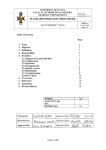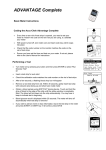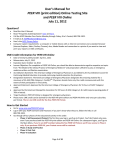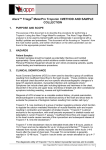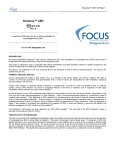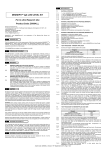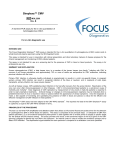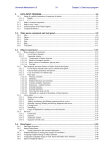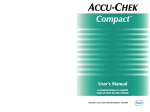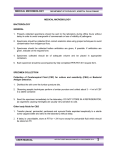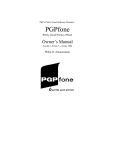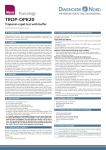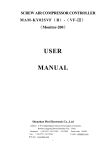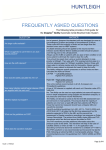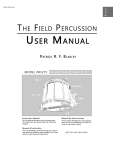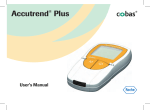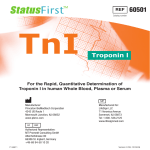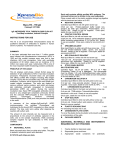Download Alere™ Triage® MeterPro D-Dimer METHOD AND SAMPLE
Transcript
1. Alere™ Triage® MeterPro D-Dimer METHOD AND SAMPLE COLLECTION PURPOSE AND SCOPE The purpose of this document is to describe the procedure for performing a D-Dimer using the Alere Triage MeterPro analyser. The Alere Triage MeterPro analyser is to be used by trained health care professionals in accordance with a facility’s policies and procedures. This document will be focusing on D-Dimer using the single Test Panel, and further information on the other parameters and multi-marker panels can be found in the appropriate product inserts. 2. HAZARDS Patient Samples All patient samples should be treated as potentially infectious and handled appropriately. Some quality control solutions contain human source material. Personal Protective Equipment should be worn when processing samples, quality control testing and maintenance procedures. 3. CLINICAL SIGNIFICANCE Venous thromboembolism is a term used for both deep venous thrombosis (DVT), which involves clot formation in the deep veins of the body and a pulmonary embolism (PE), where the clot can break off and travel to the lungs.1 PEs originate from proximal DVT of the leg (popliteal, femoral, or iliac veins), with upper extremity DVT less common but also may lead to PE, especially in the presence of a venous catheter. 2 Classic symptoms of DVT include swelling, pain, and discoloration in the affected extremity. Physical examination may reveal the palpable cord of a thrombosed vein, unilateral oedema, warmth, and superficial venous dilation. However, these symptoms are of low predictive value and can occur in other conditions such as musculoskeletal injury, cellulitis, and venous insufficiency. Diagnosis of DVT is based on the Wells clinical prediction rule, which provides a reliable estimate of the pretest probability of DVT; Doppler ultrasonography; helical computed tomography (CT); contrast venography; Impedance plethysmography and D-dimer tests.1,2 Furthermore, the diagnosis of PE is based on clinical examination and a determination of risk factors; pulmonary angiography; ventilation-perfusion scanning; helical CT scanning; and D-Dimer Tests. 1 D-Dimer is a degradation product of crosslinked fibrin.3 The D-Dimer concentration is a measure of fibrinolytic activity of plasmin in the bloodstream.4 D-Dimer concentrations are raised in the setting of acute deep vein thrombosis (increased blood clotting and fibrinolytic activity); however, an elevated D-Dimer concentration is insufficient to establish the diagnosis of PE because such values are both nonspecific and commonly present in hospitalised patients.2,3 Despite this low specificity, the sensitivity and negative predictive value of the sensitive d -dimer assay in patients with suspected VTE is extremely high, where a low d-dimer Alere Triage MeterPro D-Dimer Method and Sample Collection IECDD.5.v1 29.3.12 1 concentration (<0.5 ug/ml) can be useful in ruling out VTE in low risk patients. 3,4 Various PoCT devices measure D-Dimer and results should always be used in conjunction with clinical presentation, history and other diagnostic information. 4. TEST PRINCIPLE The Alere Triage D-Dimer Test is a single use fluorescence immunoassay device designed to determine the concentration of D-Dimer in EDTA anticoagulated whole blood or plasma specimens. The test procedure involves the addition of several drops of an EDTA anticoagulated whole blood or plasma specimen to the sample port on the Test Device. After addition of the specimen, the whole blood cells are separated from the plasma using a filter contained in the Test Device. The specimen reacts with fluorescent antibody conjugates and flows through the Test Device by capillary action. Complexes of each fluorescent antibody conjugate are captured on a discrete zone resulting in a binding assay. The concentration of D-Dimer in the specimen is directly proportional to the fluorescence detected therefore a greater amount of fluorescence indicates a higher D-Dimer concentration. Light from a laser hits a test device that has been inserted in the meter, which causes the fluorescent dye in the test device to give off energy. The more energy the fluorescent dye gives off, the stronger the signal. The results are displayed on the Meter screen in approximately 20 minutes. 4.1 Interference All drugs were tested at concentrations that represent the blood concentrations that would result from a maximal therapeutic dose and at least twice the maximal therapeutic dose. There was no significant interference with the analyte, nor was there any assay cross-reactivity. Alere Triage MeterPro D-Dimer Method and Sample Collection IECDD.5.v1 29.3.12 2 • • • • Severely haemolysed specimens should be avoided. When a sample appears to be severely haemolysed, another specimen should be obtained and tested As with any assay employing mouse antibodies, the possibility exists for interference by human anti-mouse antibodies (HAMA) in the sample. The test has been formulated to minimize this interference; however, specimens from patients who have been routinely exposed to animals or to animal serum products may contain heterophile antibodies which may cause erroneous results Haemoglobin (up to 5g/L), lipids (triolein up to 33.9 mmol/L), bilirubin (up to 0.26 mmol/L), fibrinogen (up to 1 mg/mL), fragment D (up to 20 µg/mL) or fragment E (up to 20 µg/mL) added to EDTA anticoagulated plasma containing D-dimer did not interfere with the recovery of D-dimer. The hematocrit between 30% and 55% had no significant effect on the recovery of D-dimer. Patents: Important! is possible that US other substances factors not listed above may US 5,463,467; USIt5,424,035; US 5,334,508; 5,206,147; US 5,240,860; and/or US 5,382,523; US 5,521,060; US 5,268,269; US 6,506,575; US 5,281,395 interfere with the test and cause false results. 4.2 Accuracy 0123 This product fulfills the requirements of the EU Directives. A comparison of 180 D-dimer measurements on the Alere Triage D-Dimer Test to ACCU-CHEK, ACCUTREND, COBAS, SAFE-T-PRO and SOFTCLIX the Stratus CS Acute Care Diagnostic System D-dimer method yielded the following are trademarks of Roche. statistics (Passing-Bablok regression) slope: 0.999, intercept: -85.89, and correlation Roche Diagnostics GmbH coefficient: 0.92. D-68298 Mannheim, Germany 0 5007607001 (01) – 06/07 EN 4.3 Precision Within-day www.roche.com and total imprecision were determined using the ANOVA model by testing control materials and human plasma pools that had D-dimer added at concentrations near the decision point of the assay and throughout the range of the standard curve. The study was conducted over 10 days, testing each control 10 times per day. Alere Triage MeterPro D-Dimer Method and Sample Collection IECDD.5.v1 29.3.12 3 5. INSTRUMENT Product specifications 5.1 Operating Conditions and Technical Data Temperature range 15o – 30oC Relative humidity 10 - 85% (non-condensing) Maximum altitude Not stated Position Place meter on a level, vibration-free surface, away from direct sunlight Measuring range 100 – 5,000 ng/mL Sample size Not stated Test time 20 minutes Memory 750 patient records, 200 QC sample results, 70 QC device results, 250 misc. test results, 600 User IDs Barcode scanner Optional external scanner Interface RS-232 computer interface port Battery operation Yes – 4x AA batteries Mains connection Yes – 6v at 1 amp Number of tests with fully charged batteries Approx. 100 tests Safety class Not stated Alere Triage MeterPro D-Dimer Method and Sample Collection IECDD.5.v1 29.3.12 4 Automatic power-off Yes – if left unused for 2 hours. Programmable for 0.5, 1, 2, or 4 hours Dimensions 225 x 190 x 70 mm Weight 700g excl. batteries 5.2 6. Storage and transport conditions Temperature range Meter (In original container) Not stated Relative humidity Not stated SPECIMEN REQUIREMENTS Venous whole blood or plasma collected in EDTA tubes is acceptable. Other blood collection tubes containing other additives and other blood specimen types have not been evaluated. Venepuncture (see suitable anticoagulants above) • Skin surface must be cleaned with an alcohol swab and dried well prior to collection to ensure there are no substances on the skin surface • Ensure sample is properly mixed and at room temperature before testing • Test the sample within 1 hour of collection. • Transport specimens at room temperature or chilled and avoid extreme temperatures. • Avoid using severely haemolysed specimens whenever possible. If a specimen appears to be severely haemolysed, another specimen should be obtained and tested 7. CARTRIDGES / REAGENTS 7.1 Storage and handling • Perform D-Dimer test using the following Test Devices: Alere Triage D-Dimer Test, or the Alere Triage Profiler SOB Panel (CK-MB, Myoglobin, Troponin I, BNP and D-Dimer) • Unopened Test Devices should be refrigerated at 2° - 8°C and are stable up to the expiration date. • Once removed from refrigeration, the pouched Alere Triage D-Dimer and SOB Test Device is stable for up to 14 days at room temperature, but not beyond the expiration date printed on the pouch. • Once equilibrated to room temperature, do not return the Test Device to refrigeration. • Optimal results will be achieved by performing testing at temperatures between 20-24°C. • Test Devices must be at room temperature before use (i.e. allow the unopened Test Device to sit at room temperature for at least 15 minutes) Alere Triage MeterPro D-Dimer Method and Sample Collection IECDD.5.v1 29.3.12 5 • • • • • If a kit containing multiple Test Devices is removed from refrigeration, allow the kit to reach room temperature before use. This will take a minimum of 60 minutes. Keep the Test Device in the sealed pouch until ready for use. Discard after single use The transfer pipette should be used for one patient specimen only. Discard after single use Discard the Test Devices if they are past the used by date. Expired Test Devices can produce incorrect results. The QC Device is light sensitive and should be stored in its black opaque case when not in use. 7.2 Storing information about test devices Meter data is updated via a disposable Code Chip module. The Code Chip module contains microchip circuitry embedded into a plastic housing. When inserted into the meter Code Chip module port and activated, the information is transferred into the meter’s memory. A Code Chip module typically needs to be installed only once per box of strips and remains in the meter memory. A Code Chip module does not need to remain in the meter while performing tests. 8. CALIBRATION In the self-test mode the meter scans an Internal Calibration Chip. Each calibration chip scan is used to validate and adjust, if necessary, the meter calibration. Operator calibration is not necessary. 9. Quality CONTROL Quality control material (perform as per your organisation protocol) Accurately testing known levels of D-Dimer ensures that the system and your technique used in testing give accurate results on patient tests. The control solutions have defined (known) values. The results for these solutions must first fall within a certain acceptable range in order to allow valid patient testing. A quality control test should be performed every time a new shipment of test devices are received, when a new lot number of test devices are used, if the clinical picture does not correlate with the patient test results, after major maintenance, and at a minimum of once a month. Enrolling in an External Quality Assurance Program is encouraged to objectively compare results with other users using the same method of testing. If an External Quality Assurance Program is not available, monthly lab comparison is encouraged. 9.1 Laboratory Comparison If your policy states you must perform laboratory comparison then perform a venepuncture sample for the laboratory and run sample on the Alere Triage MeterPro. Collection of both samples should occur at the same time. Record and compare the results ensuring they are in acceptable range for your organization The Alere Triage MeterPro uses the following methods for quality: Alere Triage MeterPro D-Dimer Method and Sample Collection IECDD.5.v1 29.3.12 6 • • • • Built-in QC Check Code Chip modules Electronic QC Device test Control solutions 9.2 Built-in internal QC check The Test Devices contains a built-in internal QC Check, which is performed automatically by the Meter during every assay. These assay controls in each test device monitors the assay procedure and the reagent integrity. If the results are found to be in specification, the result is allowed to be used, but if the test device’s internal quality control (QC) results are unacceptable, the results for the affected analyte(s) will not appear on the screen (instead will be flagged with an exclamation mark symbol). 9.3 Installing the Reagent, QC Sample or QC Device Code Chip modules • From the ‘Main Menu’ select ‘Install Code Chip’ using the up/down arrow keys and press ‘Enter’ to confirm selection. • Use the new Code Chip module that comes with every new box of test devices. • Compare the lot number on the code chip with the corresponding lot number on the test strip pouch. • Insert the Code Chip module into the Code Chip module Port in the lower left front corner of the meter • The meter will display a confirmation message that the information was installed into the meter and press the ‘Enter’ • Remove the Code Chip module from the Code Chip module Port. • Place the Code Chip module back into its original container for storage. NOTE: The meter will direct the user to install a Code Chip module if it is attempting to run a test and does not have the data in its memory. 9.4 Electronic QC Device test The QC Device should be run on each day of patient testing. The QC Device Code Chip Module should be performed before running a QC Device test, as stated in section 9.2 To perform a QC Device test: • Press the ‘Power’ button to turn on the meter. • Select ‘Run Test’ using the up/down arrow keys and press the ‘Enter’ key to confirm selection • Type in your identification number (User ID) if prompted. • Select ‘QC Device’ using the up/down arrow keys and press the ‘Enter’ key to confirm selection Alere Triage MeterPro D-Dimer Method and Sample Collection IECDD.5.v1 29.3.12 7 • • • • • • • Gently insert the QC Device into the meter until you feel the QC Device catch on the pin and hear a ‘click’. Press the ‘Enter’ key to start the test NOTE: The meter will prompt the user to install the QC Device Code Chip module if the QC Device has not been run before The meter pulls in the QC Device and scans it. The test device may partially move in and out of the meter several times. NOTE: After the test device has been inserted, do not push the device in further or attempt to pull it out. The device may be ejected by returning to the Main Menu and pressing the ‘Exit’ key. When the test is complete, the meter will beep, eject the device and display a Pass or Fail result on the meter’s screen Press the ‘Print’ key to make a printed copy of the results Remove the QC Device from the meter and place in the QC Device Box. Do not discard the QC Device. NOTE: The QC Device is light sensitive and should be stored in its black opaque case when not in use. Keep the QC Device free of contaminants, as dust, lint, fibers and other small particles may interfere with the QC Device. If the QC Device tests fail, wipe the QC Device clean with a lint free cloth to remove any oils, dust, fibers, or fingerprints. Do not apply any liquid to the QC Device. After cleaning the device, repeat the QC Device test. NOTE: The QC Device does not expire. 9.5 Running control solutions The QC Device Code Chip Module should be performed before running a QC Device test, as stated in section 9.2 The control solutions has two levels: • Alere Triage Total 5 Control 1 • Alere Triage Total 5 Control 2 Store the controls frozen at -20°C or colder in a non-defrosting freezer. Do not store near the freezer door. The reagents are stable until the date on the box. The reagents should not be refrozen and it is recommended that each tube be used once and discarded. Frozen control material must be brought to room temperature (at least 30 minutes) prior to use. Preparing the control solution • Remove the control solution from the freezer and allow to thaw and warm to room temperature (19°- 25°C) for at least 30 minutes. NOTE: Use within 1 hour of removal from the freezer. • Mix thoroughly by inverting the control solution tube Preparing the meter • • • • Power the meter on by pressing the ‘Power’ key. Press the ‘Enter’ key to run self-test. Select ‘Run Test’ using the up/down arrow keys and press Type in your identification number (User ID) if prompted. Select ‘QC Sample’ using the up/down arrow keys and press the ‘Enter’ key to confirm selection Alere Triage MeterPro D-Dimer Method and Sample Collection IECDD.5.v1 29.3.12 8 • Enter the QC lot number from the label on the side of the vial containing the QC Sample and press the ‘Enter’ key to confirm the number. NOTE: Only enter the four digit numeric value of the QC lot number Do not enter the preceding alpha character NOTE: If you enter a QC lot number for which there is no data in the meter’s memory, you will see a message on the meter’s screen: ‘No QC Sample Data in Memory’. Press ‘Enter’ to continue and install Code Chip module. Applying the control sample NOTE: The unopened Test Devices should sit at room temperature for at least 15 minutes before performing a test. • Open the pouch and label the Test Device. • Place the Test Device on a level, horizontal surface. • Hold the tube with the tip facing upwards, ensuring that all material is at the bottom of the tube. • Snap off the tab • Turn the tube over and dispense the entire contents into the sample port of the Test Device. • Ensure the specimen has been absorbed completely before moving the Test Device. Inserting the Test Device • Hold the Test Device by the edges and gently insert the Test Device into the meter until you feel the Test Device catch on the pin and hear a ‘click’. NOTE: After the test device has been inserted, do not push the device in further or attempt to pull it out. The device may be ejected by returning to the Main Menu and pressing ‘Exit’. • Press ‘Enter’ to start the test • The meter pulls in the test device and scans it NOTE: The Test Device must be inserted into the Meter within 30 minutes from the time the sample was added Alere Triage MeterPro D-Dimer Method and Sample Collection IECDD.5.v1 29.3.12 9 Results NOTE: Do not move the meter while a test is in progress. • The results are displayed on the screen, and automatically stored in the meter’s memory. • Results should fall within the expected ranges provided on the Expected Values card provided with the D-Dimer Controls Kit • If any of the QC Sample results are out of range, the results for that particular analyte will be displayed as light text on a dark background. 10. TEST PROCEDURE To change the meter settings, insert the Supervisor CODE CHIP module and refer to the Alere Triage MeterPro User Manual for instructions. NOTE: Prior to commencing patient testing, remove the Supervisor CODE CHIP module from the meter, return it to the storage box and place in a safe place for future use. 10.1 Performing the Test The Reagent Code Chip Module should be performed before running a patient test, as stated in section 9.2 Preparing the meter • • • • • Power the meter on by pressing the ‘Power’ key. Press the ‘Enter’ key to run self-test. Select ‘Run Test’ using the up/down arrow keys and press the ‘Enter’ key to confirm Type in your identification number (User ID) if prompted. Select ‘Patient Sample’ using the up/down arrow keys and press the ‘Enter’ key to confirm selection Type or (scan) the patient’s identification (Patient ID) then press the ‘Enter’ key to confirm. NOTE: To correct the patient ID, press the ‘Delete’ key to clear the entire ID or select the incorrect character using the keys. Then type in the correct ID. Applying the blood sample • Open the pouch and label the Test Device with the patient identification number. • Place the Test Device on a level, horizontal surface. • Using the transfer pipette, squeeze the larger (top) bulb completely and insert the tip into the specimen. Alere Triage MeterPro D-Dimer Method and Sample Collection IECDD.5.v1 29.3.12 10 Transfer pipette • • • • • Release the bulb slowly. The transfer pipette barrel should fill completely with some fluid flowing into the smaller (lower) bulb. Place the tip of the transfer pipette into the sample port of the Test Device and squeeze the larger bulb completely. The entire volume of fluid in the transfer pipette barrel must flow into the sample port. The specimen in the smaller (lower) bulb will not be expelled. Remove the transfer pipette tip from the sample port and then release the larger (top) bulb. Discard the transfer pipette. Ensure the specimen has been absorbed completely before moving the Test Device. NOTE: The Test Device must be inserted into the Meter within 30 minutes from the time the patient specimen was added Inserting the Test Device • Hold the Test Device by the edges and gently insert the Test Device into the meter until you feel the Test Device catch on the pin and hear a ‘click’ and press ‘Enter’. NOTE: After the test device has been inserted, do not push the device in further or attempt to pull it out. The device may be ejected by returning to the Main Menu and pressing ‘Exit’. • After the test device has been pulled into the meter, the meter will display a tick mark indicates tests which are selected and the absence of a tick mark indicates which tests have not been selected. • The user will be prompted to select desired analyte(s) or deselect undesired analyte(s) by pressing the number to the left of the test to toggle between selected or deselected and press the ‘Enter’ key to confirm selection • Press the ‘Enter’ key to start the test. NOTE: If no key is pressed on the Select Tests screen, the meter waits 30 seconds then proceeds using only the selected default tests. Then, if no key is pressed on the Confirmation Screen, the test proceeds after waiting 30 seconds. Results NOTE: Do not move the meter while a test is in progress. • The results are displayed on the screen, and save to the meter’s memory automatically. Alere Triage MeterPro D-Dimer Method and Sample Collection IECDD.5.v1 29.3.12 11 • • 11. Results displayed below the cut off levels will have no box around the result. Results in the indeterminate range have a black border around the result. Abnormal results are in a filled black box. Results can be printed by pressing the ‘Print’ button. NOTE: A panel with multiple analytes will still be able to report patient results on those analytes which passed QC. An analyte that failed QC will not be reported on patient tests (instead will be flagged with a # symbol). RESULTS 11.1 Expected values The measuring range is 100 – 5,000 ng/mL. Values above or below this range will are displayed as >5,000 ng/mL or <100 ng/mL, respectively. 11.2 Interpretation of results D-Dimer Concentration Remarks <500 ng/mL Pulmonary embolism/ DVT unlikely. If clinical suspicion remains, follows standard investigation procedures. Pulmonary embolism/ DVT cannot be ruled out. Follow standard investigation procedures for the investigation of pulmonary embolism/ DVT. > 500 ng/mL 11.3 Transferring Data to a printer or computer • To review previous results, turn on the meter by pressing the ‘Power’ button • Select ‘Recall Results’ using the up/down arrow keys and press the ‘Enter’ button to confirm. • Enter your User ID if prompted and press ‘Enter’ • Select ‘Panel Type’ using the up/down arrow keys • Use the left/right arrow keys to select the desired panel. • Select the results based on Patient ID, Test Device Lot Number (L/N), User ID, from date, till date. • Use the left/right arrow keys view the results. • Press the ‘Print’ key to make a printed copy or press the ‘Enter’ key to upload the selected results to LIS. Alere Triage MeterPro D-Dimer Method and Sample Collection IECDD.5.v1 29.3.12 12 12. MAINTENANCE • • • • • Clean the exterior using a damp sponge or cloth with mild soap and water solution Wipe the meter dry using a soft cloth or absorbent tissue. Do not allow water to seep into the printer. Do not immerse the meter in water or other liquids. If blood or other fluids are not allowed enough time to fully absorb into test devices, the device track door may occasionally require cleaning. Using a cotton swab dampened with isopropyl alcohol and a pair of tweezers, carefully lift the door and clean both front and back of the door. Changing Paper • Tear off any excess paper sticking out of the Meter • Remove the paper compartment cover by pulling up on the cover as indicate by the arrow on the back of the cover. • Remove unused paper or the empty paper spindle from paper compartment. • Cut a clean, straight edge to feed into the printer. Do not cut paper at an angle, as the printer must sense the edge of the paper along the feed path. • Insert the new roll of paper into the paper compartment. • Position the paper such that the paper will feed from under the roll (as opposed to over the top of the roll • Insert the paper edge under the paper roller (platen) until it firmly seats or resistance is felt. • Press the ‘Print’ key. • Replace the cover of the printer and continue operation. 13. REFERENCES This method has been adapted from the Alere Triage MeterPro System User Manual, Test Device and control solution package inserts. 1. Ramzi, DW & Leeper, KV 2004, ”DVT and Pulmonary Embolism: Part I Diagnosis”, Alere Triage MeterPro D-Dimer Method and Sample Collection IECDD.5.v1 29.3.12 13 Am Fam Physician, vol. 69, no. 12, pp. 2829-2836. 2. Fancher, TL, White RH & Kravitz, R 2004, ‘Combined use of rapid D-dimer testing and estimation of clinical probability in the diagnosis of deep vein thrombosis: systematic review’, BMJ, pp. 329 – 821. 3. Harrison, A 2005, ‘Evaluation and management of the acutely dyspneic patient: the role of biomarkers”, American Journal of Emergency Medicine, vol. 23, pp. 371–378. 4. Roche Diagnostics, 2007 ,’Roche CARDIAC D-Dimer’, Cobas h232 Test strip package insert, Mannheim, Germany. Alere Triage MeterPro D-Dimer Method and Sample Collection IECDD.5.v1 29.3.12 14














